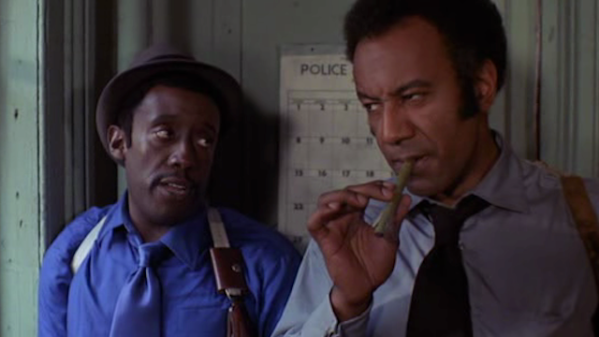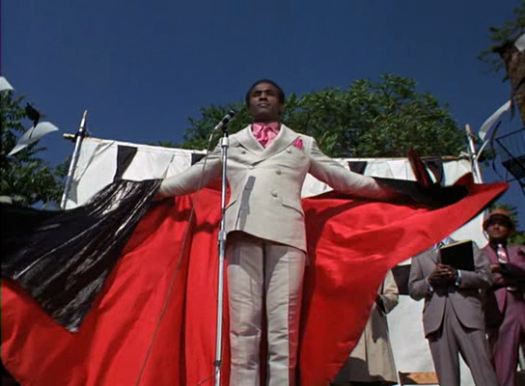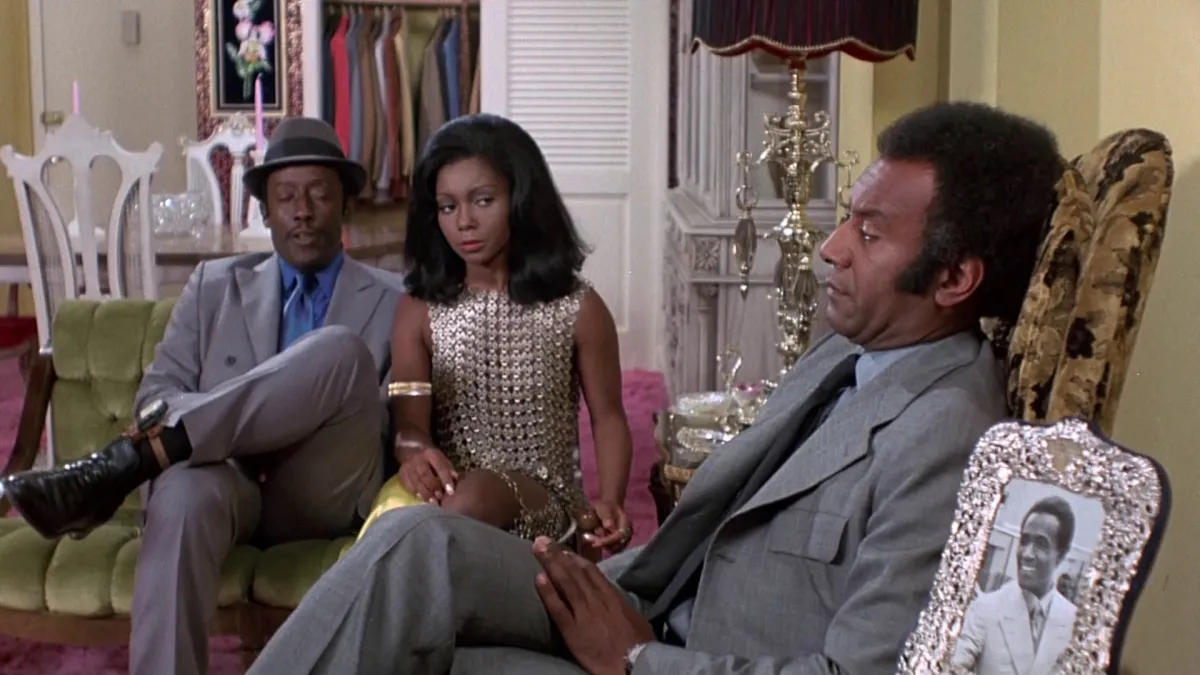“Keep it Black until I get back.”
The names Melvin Van Peebles and Gordon Parks are often cited for their contribution to the foundation of Blaxploitation. Peebles for his groundbreaking film Sweet Sweetback’s BaadAsssss Song, one of the first truly independent features, and Parks for his iconic Shaft.
Blaxploitation is a genre that exploded during the 70s, featuring Black stars, Black music, and Black stories that often left good taste at the door and threw everything and the kitchen sink at the plot. It is a complex genre that by its very existence is political. It is a genre that earns both the “Black” and the “sploitation” implied by its name.

Yet, as crucial as Peebles and Parks, were to the genre, Ossie Davis’s 1970 Cotton Comes to Harlem is every bit as foundational. Davis is fondly, and rightly, remembered for his performances as a Tony Award-winning actor and his work as a civil rights activist. But while his time behind the camera is dwarfed by this time in front of it, his time in the director chair, while brief, laid down a blueprint for the genre.
Adapted from a Chester Himes novel of the same name by Davis and Arnold Perl, the film takes a story we’ve seen a hundred times before but transplants it to Harlem. Davis is one of the first directors to use Harlem as a setting, something that would become common in Blaxploitation films afterward, including Peeble’s iconoclastic Sweet Sweetback BaadAsssss Song that would come out the following year.
In Odie Henderson’s book Black Caesars and Foxy Cleopatras: A History of Blaxploitation Cinema, Davis explains how important the setting of Harlem was to the film. “Harlem has been an example of oppression, a symbol of what remains to be done. It has also been an example of the exotic, the quaint, the different-how Black people live.” As shot by Gerald Hirshcfield, Harlem is a living breathing time capsule of a place and its people captured amid an over-the-top police procedural farce.
Cotton Comes to Harlem is a police procedural with two black cops trying to take down a corrupt preacher. But more importantly, it’s an attempt to invert and erase tropes and racist caricatures that Hollywood had spent decades spewing out. Davis continues in the book, “We are creating a totally new stereotype to replace the one that has become obsolete.”
Gone are the buffoons and the noble Black characters with all the edges sanded off for white consumption. Enter the wisecracking, knuckle-cracking, hard-headed Detective Coffin Ed Johnson (Raymond St. Jacques) and Gravedigger Jones (Godfrey Cambridge). They’re not the Sidey Poiter-inspired characters you would see on so many 70s TV shows and films of the time. However, Hirschfeld and Davis slyly recreate and repurpose the iconic flare scene from Joseph L. Mankiewicz’s 1950 Now Way Out, starring Poitier in one of the film’s best scenes.
Aside from having quite possibly the coolest and baddest names of any character of the 70s or any time, Coffin Ed and Digger Jones could be a precursor to Gene Hackman and Roy Schiender’s Popey Doyle Cloud Russo from William Friedkin’s The French Connection, which would also come out just a year later. Or any buddy cop movie from that decade. From breaking and entering to intimidating witnesses such as Reverand Deke’s girlfriend Iris (Judy Pace), the duo are less interested in the rules than doling out justice on their terms.
The two share the same sensibilities and beliefs but are sometimes on different pages. Cambridge’s Digger is the level-headed sidekick with a dry wit. “Honkies in the woodpile.” In contrast, St. Jacques’s Coffin, while equally deadpan, is weary and disillusioned. The two balance each other out as it is quite literally them against the white world.
After the robbery, their white commissioner Bryce (John Anderson) orders O’Malley to get police protection. But Coffin is more outraged at the $87,000 that was stolen from poor Black people from all across the country. Davis and Perl’s script is less concerned with whether or not O’Malley is crooked, we find out pretty early he is, but rather who has the money.
Much of the grit and intimate framing Herschfield’s camera brought to Cotton Comes to Harlem became a staple not merely in Blaxploitation but in the decade itself. The car chase scene is a prime example, with how Davis and Hirschfeld frame the chase both putting us inside the cab and allowing us to see the cars take those jack-knife turns. Davis’s debut had its finger on the pulse of a shifting Hollywood as well as a burgeoning genre. Cotton Comes to Harlem is at once a retooling of an aging story and its tropes while also the beginning of a new era with its own cliches and beats.
Take the characters Coffin Ed and Gravedigger Jones for starters. To my knowledge, they are the only two Black police detectives who support Black nationalism. This is revealed while the two interrogate Calvin Lockhart’s scheming Reverend Deke O’Malley. “You could have been another Marcus Garvey or even another Malcolm X, but instead you ain’t nothin’ but a pimp with a chickenshit backbone.”
Cambridge and St. Jacques make for two stone-cold leads. Each brings a kind of sizzling magnetism to the role. Each radiates a kind of laconic observationalism. Think Jack Webb from Dragnet but with a personality and a pulse. They set the standard for being cool while poking fun at the cop performances, of the straight-laced, upstanding, detectives the Studios made popular.
Lockhart’s O’Malley is behind a “Back to Africa” scheme that’s scamming the residents of Harlem, as well as Blacks from other big cities, into buying shares of “Black Beauty”, an ark-like ship to take them all back to Africa. Only the money is going to the not-so-good Reverend and his partner Calhoun (J.D. Cannon). Deke’s brand of chicanery rubs the two detectives the wrong way. They’re used to white people stealing from and exploiting Black people, but to have it be done by one of their own, infuriates them.

O’Malley is a quick-thinking, smooth-talking scam artist. A selfish lout, terrified of being trapped in Harlem. He splendidly shows the vulnerability and insecurities that drive his O’Malley, a man riddled with greed and selfishness but who cannot stand to not be adored and loved. Yet, the man has some serious fashion sense. The cape he wears at the beginning is as slick now as it was then. We see how a crowd could be enraptured by the man.
Davis sprinkles in comedy with the action. After Rverened Deke’s rally is robbed, the detectives give chase to the robbers. The ensuing car chase is at once thrilling but also hilarious, as Davis and Hirschfeld cut away from the swerving cars to life on the streets. These scenes range from a two-man team working a con on an old lady to a young man fawning over three well-dressed Black ladies. My favorite was the cutaway that showed the local undertaker witnessing the chase and giddily getting ready for new business.
Davis and Perl subvert tropes like turning the tables on white cops. One white-beat cop Jarema (Dick Sabol) is constantly humiliated and tricked throughout the film. Mostly due to his own ineptness and arrogance. One scene has him being seduced by Pace’s Iris in a protracted scene that ends with him naked and with a paper bag over his head while she escapes his custody. After years of forcing Black characters to act the fool, Davis and Perl get a little bit of revenge.
The question at the center of the film however is: what is a bale of cotton doing in Harlem? A question that gets asked repeatedly by everyone in the film. The infamous bale of cotton takes on a journey worthy of its own film as it goes from the curbside to a junkyard, until finally ending up onstage as part of a striptease act.
But what really sets Cotton Comes to Harlem apart from its predecessors is that it’s fun. Godfrey Cambridge remarks in Henderson’s Black Caesars and Foxy Cleopatras, that it was ”the first major motion picture to be made within and about the black American lifestyle that is concerned mainly with entertaining and not with preaching equality.” Cotton Comes to Harlem is a movie that dares to say that not only do Black people go to the movies but that they might go to the movies for the same reason as white people: to be entertained.
All through Cotton Comes to Harlem, is the vein of comedy that ranges from sly to cartoonish. Davis and Perl walk a razor-thin line in Cotton Comes to Harlem. They’ll have Coffin Ed and Digger Jones say, “We may have broken a few heads but we ain’t never broke a promise,” in one scene but then have them cartoonishly throw a pickpocket up in the air ala Bugs Bunny. The car chase from earlier in the movie even ends with Coffin Ed and Digger Jones crashing into a cart of watermelons.

Cotton Comes to Harlem is stuffed, like the bale of cotton, with a trove of crips and wry dialogue. “White shit about to hit black fan.” The comedy is embedded deep in the sinew of the movie. It’s a comedy of the absurd.
Ironically, Chester Himes, the author of the book, never saw his stories as all that absurd. Henderson quotes Himes, “It never occurred to me that I was writing absurdity. Realism and absurdity are so similar in the lives of American Blacks one cannot tell the difference.” Davis acknowledges this as he and Perl set the serious moments right up against the silly ones, oftentimes within the same scene.
Cotton Comes to Harlem switches gears from blistering violent, to dry sardonic wit, to thrilling car chases, and never once misses a beat. The dialogue has a musicality to it, a rhythm, a reminder of Davis and Perl’s theatrical background.
Digger Jones: Ratting on the mob ain’t the worst thing in the world. Any black man might rat on whitey. I might, myself.
Coffin Ed: Man, like Deke, preying on his own black flesh and blood.
Digger Jones: How you going to blame Deke for what everybody else is doing?
Coffin Ed: Beats me how you can find any good at all in the vicious son of a bitch.
Digger Jones: Convicting the man without a trial, ain’t you, God.
The characters run the gamut from weird to tragic. Characters like Uncle Budd (Redd Foxx) a wino who discovers a bale of cotton and spends much of the movie trying to sell it. Or Lo Boy (Cleavon Little) the dope addict and witness to the robbery of O’Malley’s fundraising rally. Cotton Comes to Harlem is stuffed with a cast of who’s who of character actors that would go on to define the decade, from Leonardo Cimino to Helen Martin, the streets of Davis’s films are filled with familiar faces.
The title song, “It Aint’ Now, But It’s Gonna Be”, sung by legendary Melba Moore even alerts the audience that Cotton Comes to Harlem is going to be different. Penned by Davis, the lyrics seem to be speaking directly to an oft-ignored Black audience while also announcing the dawn of a new era. “Ain’t now but it’s gonna be/Black enough to be/Black enough to see/Black enough for me”. Cotton Comes to Harlem set the stage not for merely Blaxploitation but for the 70s themselves.
Cotton Comes to Harlem is currently available on Tubi. If you wish to learn more about Blaxploitation check out Odie Henderson’s invaluable book Black Caesars and Foxy Cleopataras: A History of Blaxploitation Cinema.
Images courtesy of United Artists
Have strong thoughts about this piece you need to share? Or maybe there’s something else on your mind you’re wanting to talk about with fellow Fandomentals? Head on over to our Community server to join in the conversation!

